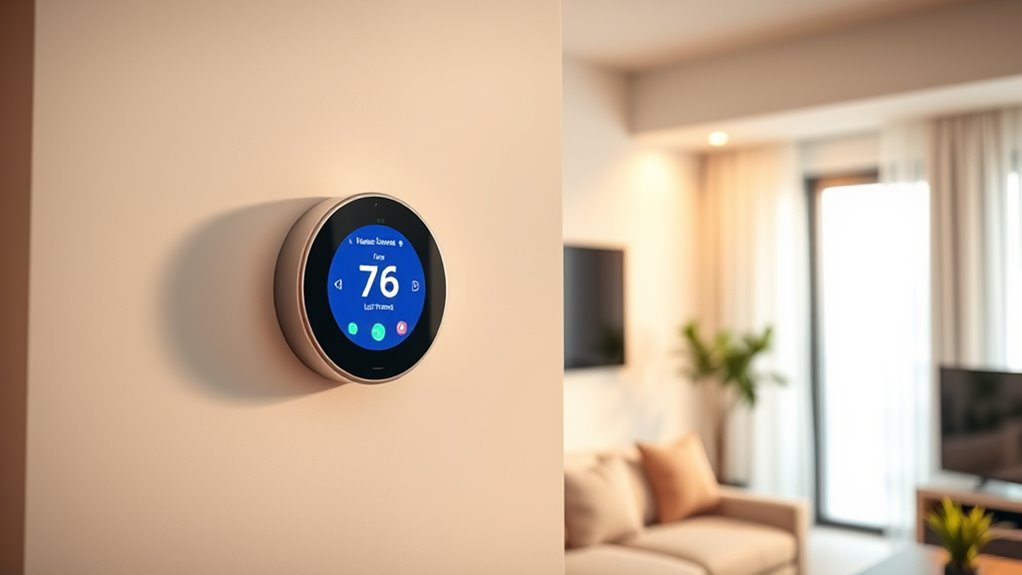If you want a smart thermostat that simplifies your home climate control, I recommend models with robust learning features like the Nest Learning Thermostat and ecobee Smart Thermostat. These devices automatically adapt to your routines, preferences, and presence, helping you save energy and stay comfortable. They integrate easily with smart home systems and often include sensors for multi-room control. Keep exploring to find the best option tailored to your needs and how they work.
Key Takeaways
- Many top smart thermostats, like Nest and ecobee, feature advanced learning algorithms that adapt to your routines for optimal comfort and efficiency.
- These thermostats automatically create personalized schedules, reducing manual adjustments and simplifying home climate management.
- Learning-enabled models support features like Home/Away Assist and sensor integration for consistent temperature control across rooms.
- Compatibility with smart home ecosystems and remote control options enhance convenience and streamline climate automation.
- Energy-saving capabilities and real-time usage insights help lower utility bills while maintaining tailored home comfort.
Nest Learning Smart Thermostat, 3rd Generation
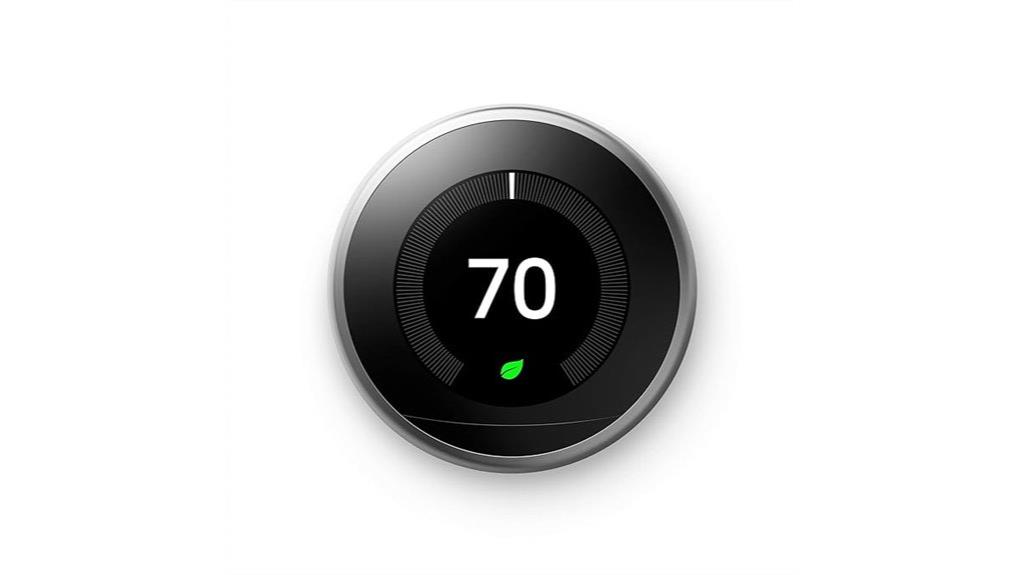
If you’re looking for a smart thermostat that adapts seamlessly to your routines, the Nest Learning Smart Thermostat, 3rd Generation, is an excellent choice. It features a sleek stainless steel design, a bright digital display, and round shape, making it both stylish and functional. Compatible with air conditioners and heating systems, it offers control via Wi-Fi, Bluetooth, Alexa, and Google Assistant. Its Auto-Schedule learns your preferences, while Home/Away Assist saves energy by adjusting settings when you’re not home. You can control it remotely through the app, monitor energy use, and benefit from voice commands—all with a reliable internet connection.
Best For: homeowners and office managers seeking an energy-efficient, easy-to-use smart thermostat that adapts to their routines and integrates with voice assistants.
Pros:
- Learns your schedule and preferences to automatically adjust temperature for optimal comfort.
- Supports remote control via the Nest app, voice commands, and compatibility with Alexa and Google Assistant.
- Helps save energy and reduce costs through Home/Away Assist and energy usage insights.
Cons:
- Requires a stable Wi-Fi connection for full functionality.
- Compatibility with existing HVAC systems should be verified using Google’s Nest Compatibility Checker.
- Advanced features may require a learning curve for new users unfamiliar with smart thermostats.
Google Nest Thermostat, Programmable Wi-Fi Smart Thermostat
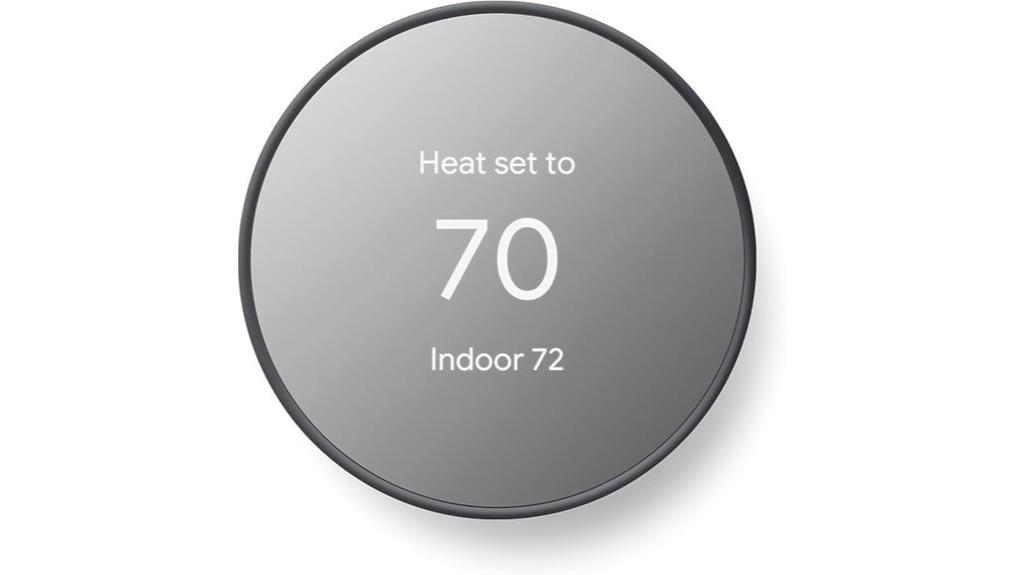
The Google Nest Thermostat stands out for its ability to learn your heating and cooling preferences over time, making it an ideal choice for homeowners seeking a hands-off approach to energy management. It’s compatible with Google Assistant, Alexa, and Matter-certified voice assistants, offering remote control via the Google Home app on Android or iPhone. Designed for easy DIY installation, it works with most HVAC systems, even without a C wire. The thermostat helps save energy by adjusting settings when you’re away, monitors your system for issues, and provides alerts. Its ENERGY STAR certification ensures efficient operation, all in a sleek charcoal design that fits seamlessly into any home.
Best For: homeowners seeking an easy-to-install, energy-efficient smart thermostat that adapts to their heating and cooling preferences and offers remote control via voice or app.
Pros:
- Easy DIY installation compatible with most HVAC systems, even without a C wire
- Supports remote control and voice commands through Google Assistant, Alexa, and Matter-certified assistants
- Monitors HVAC system health and provides maintenance alerts to prevent issues
Cons:
- Some systems may require additional accessories for installation
- Alerts do not replace professional diagnosis for system problems
- Limited to 24V HVAC systems, may not suit all existing setups
Google Nest Thermostat (4th gen) + Sensor (2nd gen)
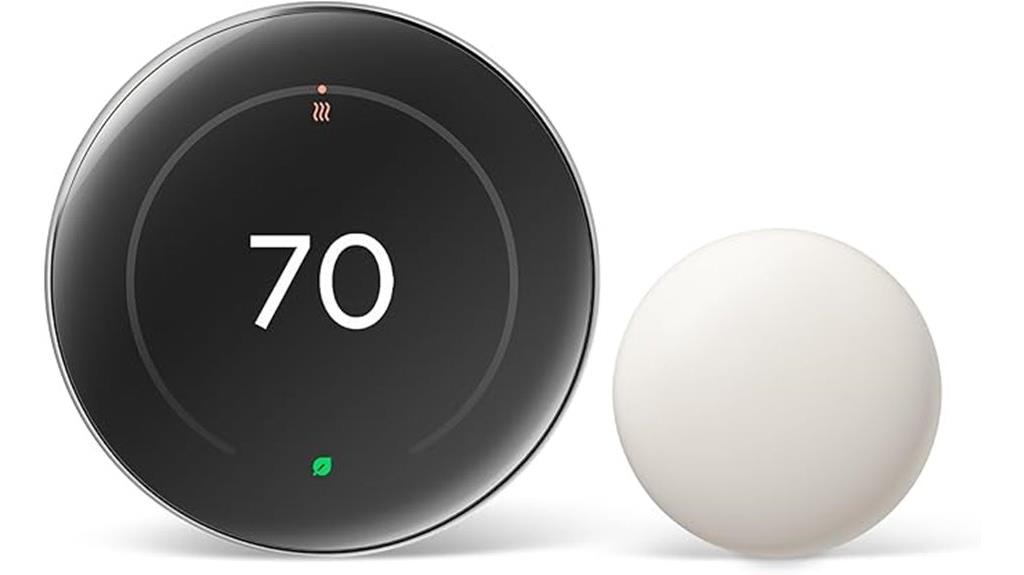
The Google Nest Thermostat (4th gen) combined with the 2nd gen Sensor stands out for anyone seeking precise room-by-room climate control and energy savings. Its larger display with Dynamic Farsight makes information visible from across the room, while customizable designs enhance its aesthetic. The thermostat easily fits most 24V systems and is simple to install, with self-setup and Matter support for smart home integration. It learns your preferences and adjusts automatically, helping reduce energy bills. The included Nest Temperature Sensor allows you to manage hot and cold spots in different rooms, ensuring comfort and efficiency tailored to your schedule.
Best For: homeowners seeking a sleek, smart thermostat with precise room-by-room climate control and energy-saving features.
Pros:
- Large, dynamic display with Farsight visibility from across the room
- Easy to install, self-setup, and compatible with most 24V systems without needing a C wire
- Learns user preferences and adjusts heating and cooling automatically to save energy
Cons:
- May require additional sensors for optimal multi-room control, increasing cost
- Some users might find the customization options limited compared to more advanced thermostats
- Dependence on Wi-Fi and smart home integrations may pose issues during connectivity outages
Google Nest Thermostat, Programmable WiFi Smart Thermostat
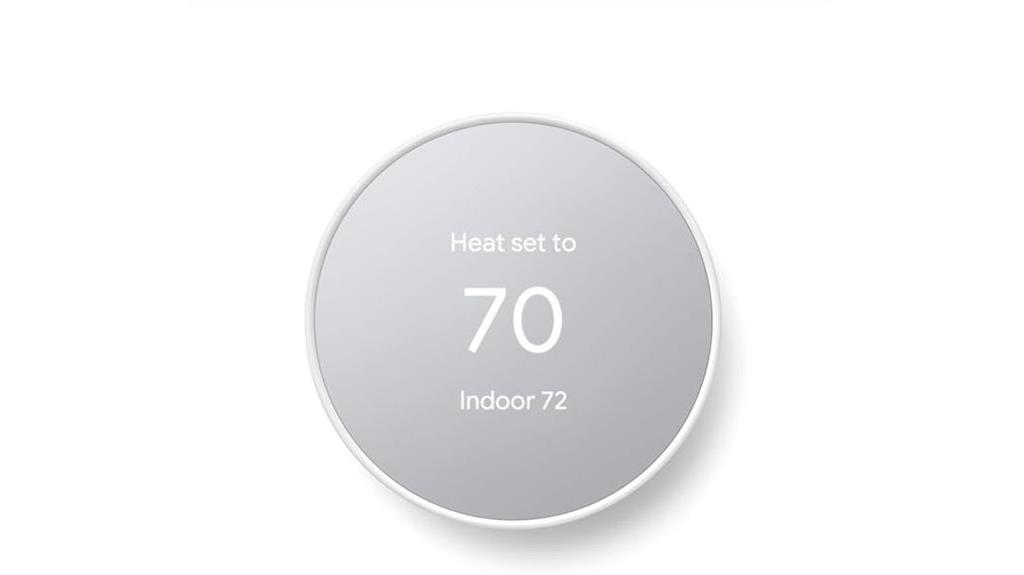
For homeowners seeking an energy-efficient smart thermostat that adapts to their schedule, the Google Nest Thermostat offers a compelling choice. It’s ENERGY STAR certified, supports Wi-Fi, and works without a C wire in most homes, making setup straightforward. The device learns your routines, adjusts temperatures automatically, and helps reduce energy waste by turning down when you’re away. You can create custom schedules via the Google Home app and control the thermostat remotely from your phone or tablet. With integration into Google Assistant, Alexa, and Matter, it’s versatile and easy to use. Plus, features like HVAC monitoring and energy-saving suggestions help optimize comfort and efficiency effortlessly.
Best For: homeowners seeking an energy-efficient, easy-to-install smart thermostat that adapts to their schedule and integrates seamlessly with voice assistants.
Pros:
- Supports Wi-Fi connectivity and works without a C wire in most homes for straightforward setup
- Learns routines and adjusts temperatures automatically to optimize energy savings
- Compatible with Google Assistant, Alexa, and Matter for versatile voice control
Cons:
- Some heating-only or cooling-only systems may require an additional power accessory or C wire
- Does not include a lock function by default, which may be a concern for households with children
- Advanced features like HVAC monitoring and energy-saving suggestions may require app navigation and setup
Honeywell Wi-Fi Smart Color Thermostat

If you’re looking to match your thermostat to your home’s decor while enjoying advanced climate control, the Honeywell Wi-Fi Smart Color Thermostat is a smart choice. It offers customizable color options to blend seamlessly with your interior style. Compatible with most forced air systems, hot water, steam, and heat pumps with electric backup, it supports remote control via Wi-Fi and integrates with Alexa, Google Home, and Honeywell’s app. The Energy Star certified device helps reduce energy costs with programmable scheduling and energy reports. Just guarantee your home has a C-wire, as it’s required for operation, and verify compatibility before installation.
Best For: homeowners seeking a customizable, energy-efficient smart thermostat that seamlessly integrates with voice assistants and matches their interior decor.
Pros:
- Customizable color options to match home décor
- Compatible with various heating systems including heat pumps and hot water systems
- Supports remote control via Wi-Fi and integrates with Alexa, Google Home, and Honeywell’s app
Cons:
- Requires a C-wire for installation and operation
- Not compatible with electric baseboard heating (120-240V)
- May need verification of home system compatibility before purchase
Google Nest Learning Thermostat and Temperature Sensor Bundle
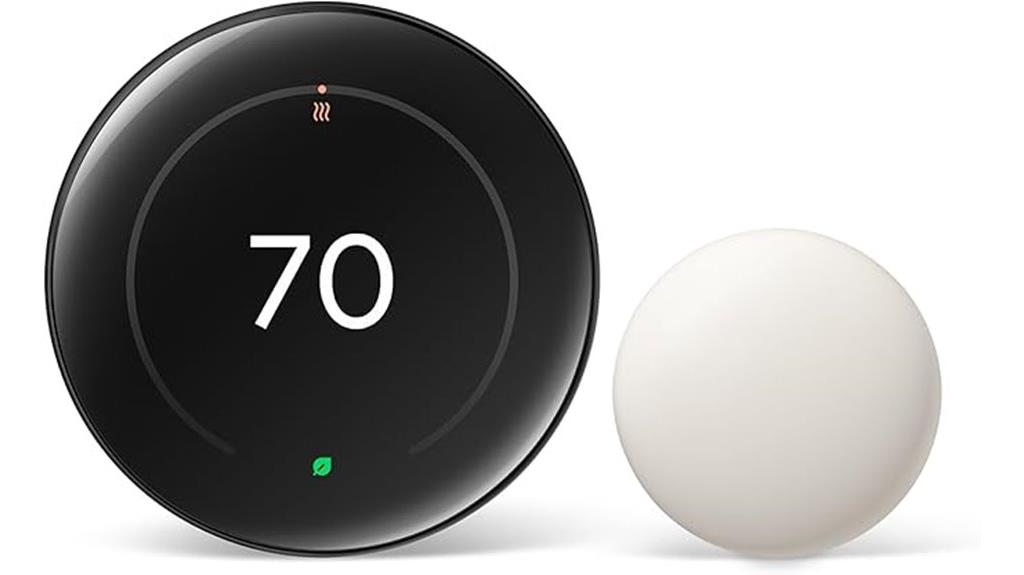
Anyone looking to optimize home comfort and energy savings will find the Google Nest Learning Thermostat and Temperature Sensor Bundle an excellent choice. This sleek, 4th-generation thermostat features a larger, easy-to-read touchscreen with Dynamic Farsight for visibility from across the room. It learns your routines, adjusts for sunlight, and uses outdoor data to optimize heating and cooling, saving about 12% on heating bills and 15% on cooling. The included Nest Temperature Sensor helps manage hot and cold spots in different rooms. Control is simple via the app, voice, or smart home systems like Alexa and Google Assistant. Its compatibility, stylish design, and intelligent features make it a standout option.
Best For: homeowners seeking an intelligent, energy-efficient thermostat that adapts to their routines and integrates with smart home systems.
Pros:
- Learns user preferences and routines for optimized comfort and energy savings
- Supports multiple control methods including app, voice, and smart home ecosystems
- Stylish design with a larger, easy-to-read touchscreen and customizable display
Cons:
- May require a C wire for installation in some homes
- Higher upfront cost compared to basic thermostats
- Limited compatibility with non-24V HVAC systems
Google Nest Learning Thermostat (4th Gen, 2024) with Nest Temperature Sensor

The Google Nest Learning Thermostat (4th Gen, 2024) with Nest Temperature Sensor stands out for homeowners seeking a sleek, highly customizable smart thermostat that adapts seamlessly to their routines. Its polished gold finish and larger display with Dynamic Farsight make it both stylish and easy to read from across the room. It works with most 24V systems and requires no C-wire in many cases, making installation simple. Compatible with various smart home ecosystems, it can be controlled via the Google Home app or voice commands. Using Nest Temperature Sensors, it manages hot and cold spots efficiently, optimizing comfort and energy savings automatically.
Best For: homeowners seeking a stylish, highly customizable smart thermostat that easily integrates with existing smart home systems and optimizes energy efficiency.
Pros:
- Sleek design with polished gold finish and larger display with Dynamic Farsight for easy readability.
- Compatible with most 24V systems and no C-wire needed in many homes, simplifying installation.
- Advanced learning capabilities and Nest Temperature Sensors for personalized comfort and energy savings.
Cons:
- May require app setup and updates, which could be a learning curve for some users.
- Limited compatibility with non-24V systems or older heating/cooling setups.
- Higher upfront cost compared to basic thermostats, though offset by energy savings.
Google Nest Learning Thermostat, 3rd Gen

The Google Nest Learning Thermostat (3rd Gen) stands out for its ability to learn your schedule and temperature preferences, making it ideal for anyone seeking a hands-off, energy-efficient climate control solution. It seamlessly blends into modern homes with its sleek stainless steel finish and is compatible with Alexa. The thermostat automatically adjusts settings based on your routines, while Home/Away Assist switches to Eco Mode when you’re gone, saving energy. You can control it remotely from your phone or tablet, and view energy history to track savings. It also monitors HVAC systems, providing alerts and maintenance reminders to keep everything running smoothly.
Best For: homeowners seeking an easy-to-use, energy-efficient smart thermostat that adapts to their schedule and preferences.
Pros:
- Learns user routines to optimize comfort and energy savings automatically
- Compatible with Alexa and features a sleek stainless steel design that fits modern interiors
- Provides remote control, energy usage insights, and HVAC monitoring for convenience and maintenance
Cons:
- Requires separate purchase of Nest Temperature Sensors for room-specific temperature control
- Limited to compatible HVAC systems, which may exclude some older or specialized setups
- May have a learning curve for users unfamiliar with smart home devices
ecobee Smart Thermostat Essential, Wi-Fi Programmable Thermostat
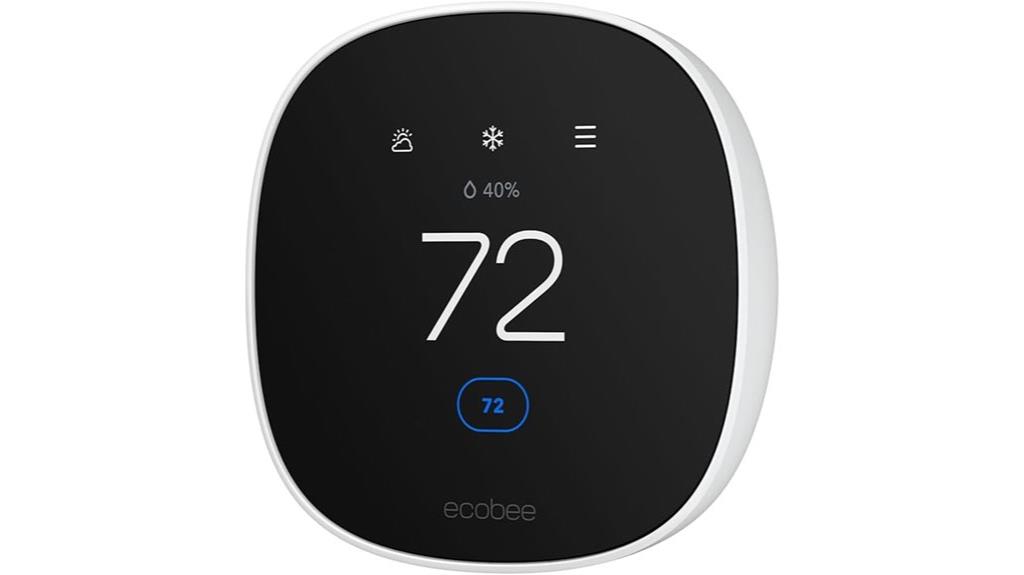
If you’re looking for an energy-efficient, easy-to-install smart thermostat that works seamlessly with popular voice assistants, the ecobee Smart Thermostat Essential is an excellent choice. It’s Energy Star certified, compatible with most 24 VAC HVAC systems, and doesn’t require a C-wire thanks to the Power Extender Kit. With its sleek LCD touchpad and app control, you can easily set schedules, monitor energy use, and adjust temperatures remotely. It saves up to 23% on heating and cooling costs annually, paying for itself in just six months. Plus, it works with Siri, Alexa, and Google Assistant, making home climate control effortless.
Best For: homeowners seeking an energy-efficient, easy-to-install smart thermostat compatible with popular voice assistants and adjustable via app or touchpad.
Pros:
- Compatible with most 24 VAC HVAC systems and doesn’t require a C-wire with the PEK kit.
- Saves up to 23% annually on heating and cooling costs, providing quick ROI.
- Supports voice control via Siri, Alexa, and Google Assistant for seamless home automation.
Cons:
- Requires Wi-Fi connectivity for full functionality, limiting use without internet.
- Some advanced features, like SmartSensor integration, are sold separately.
- Customer support and warranty details depend on product registration and retailer policies.
Amazon Smart Thermostat
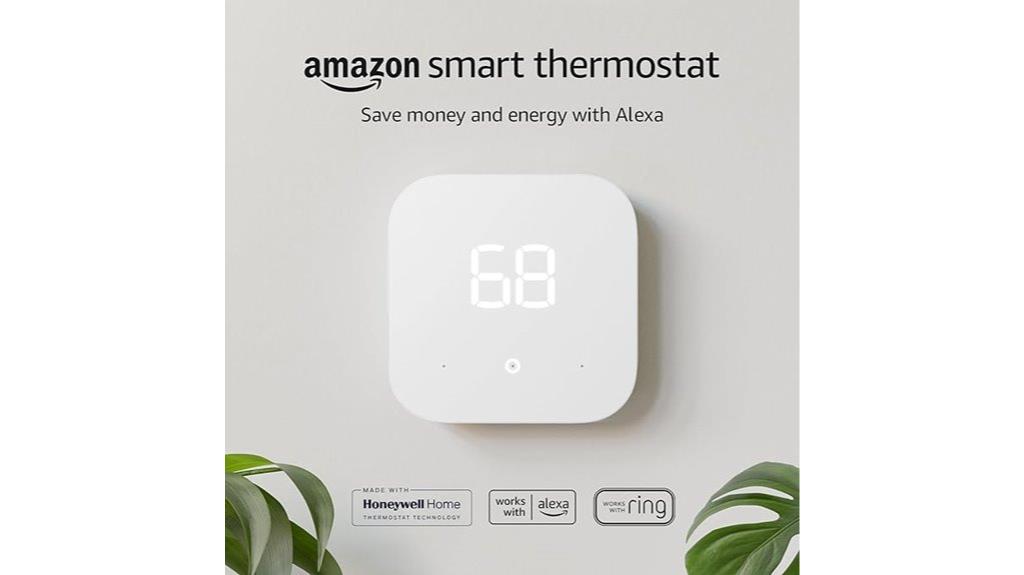
For homeowners seeking an easy, voice-controlled upgrade to their existing HVAC system, the Amazon Smart Thermostat stands out with its learning features and seamless integration with Alexa. It automatically adjusts temperatures based on presence detection and user behavior, learning your preferences over time. You can control it remotely via the Alexa app or through voice commands on compatible Echo devices. Features like scheduling, vacation mode, emergency heat, and automatic air filter ordering make it versatile. Certified ENERGY STAR, it can save about $50 annually on energy bills. Installation is straightforward, but a C-wire is typically needed. Overall, it’s a smart, reliable choice for effortless home climate management.
Best For: homeowners seeking an easy, voice-controlled upgrade to their existing HVAC system with learning capabilities and seamless Alexa integration.
Pros:
- Supports automatic temperature adjustments based on presence detection and user behavior, learning preferences over time.
- Can be controlled remotely via the Alexa app or voice commands on compatible Echo devices for convenience.
- Certified ENERGY STAR, offering potential energy savings of around $50 annually and features like scheduling and automatic air filter ordering.
Cons:
- Requires a C-wire for proper installation, which may not be present in all homes.
- Not compatible with high-voltage systems such as electric baseboard heating or 110-240V systems.
- No built-in microphone; voice control depends on pairing with an Echo device, limiting direct voice interaction at the thermostat.
Google Nest Thermostat, Programmable Wi-Fi Smart Thermostat

Anyone looking to save energy without sacrificing comfort will find the Google Nest Thermostat an excellent choice. It’s ENERGY STAR certified, helping you reduce energy use while maintaining your preferred temperature. The thermostat supports voice control via Google Assistant, Alexa, and Matter devices, and you can control it remotely through the Google Home app on Android or iPhone. Installation is quick, usually taking about 30 minutes, and it works with most heating and cooling systems, including heat pumps and zone controls. With features like programmable scheduling, energy-saving suggestions, and integration with Nest Renew for cleaner energy use, it offers convenience and efficiency in one sleek package.
Best For: homeowners seeking an energy-efficient, easy-to-install smart thermostat that offers remote control and voice command capabilities.
Pros:
- Supports voice control via Google Assistant, Alexa, and Matter-compatible devices for hands-free operation
- ENERGY STAR certified, promoting energy savings and environmental responsibility
- Compatible with most heating and cooling systems, including heat pumps and zone controls, with quick installation
Cons:
- May require additional accessories for systems without a C wire
- Some features, like HVAC monitoring alerts, are informational and not diagnostic
- The design, with a round LED or LCD display, may not suit all aesthetic preferences
Honeywell Home RTH9600WF Smart Color Thermostat
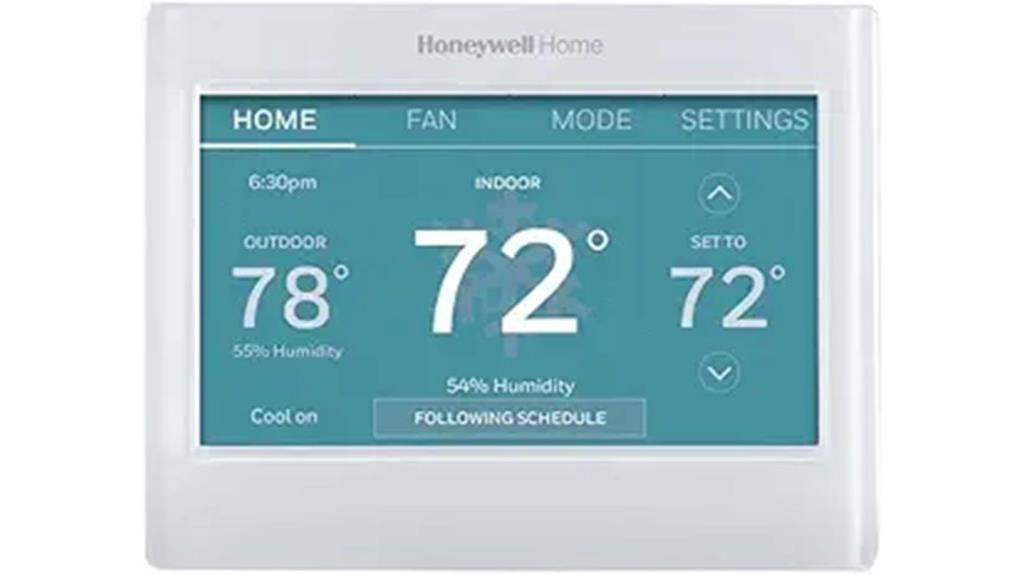
The Honeywell Home RTH9600WF Smart Color Thermostat stands out for its vibrant high-definition color display, making it an excellent choice for users who want both style and functionality. It provides on-screen comfort info like indoor/outdoor temperature, humidity, and weather forecasts, enhancing user experience. Certified ENERGY STAR, it promotes energy savings by monitoring heating and cooling. Compatible with various systems, including forced air and heat pumps, it offers remote control via app and integration with Alexa, Google, and Cortana. The thermostat supports customizable display colors and helps track energy use, with potential rebates and incentives to maximize savings. It’s a versatile, user-friendly choice for smarter climate control.
Best For: homeowners seeking an energy-efficient, stylish, and versatile smart thermostat compatible with multiple heating and cooling systems and smart home platforms.
Pros:
- Vibrant high-definition color display for easy on-screen information and customization
- ENERGY STAR certified, promoting energy savings and environmental benefits
- Compatible with popular smart home platforms like Alexa, Google Assistant, and Cortana for remote control
Cons:
- Requires a C-wire for installation, which may not be available in all homes
- Not suitable for electric baseboard heating systems (120-240V)
- May be complex for users unfamiliar with smart home or thermostat installations
Sensi Smart Thermostat
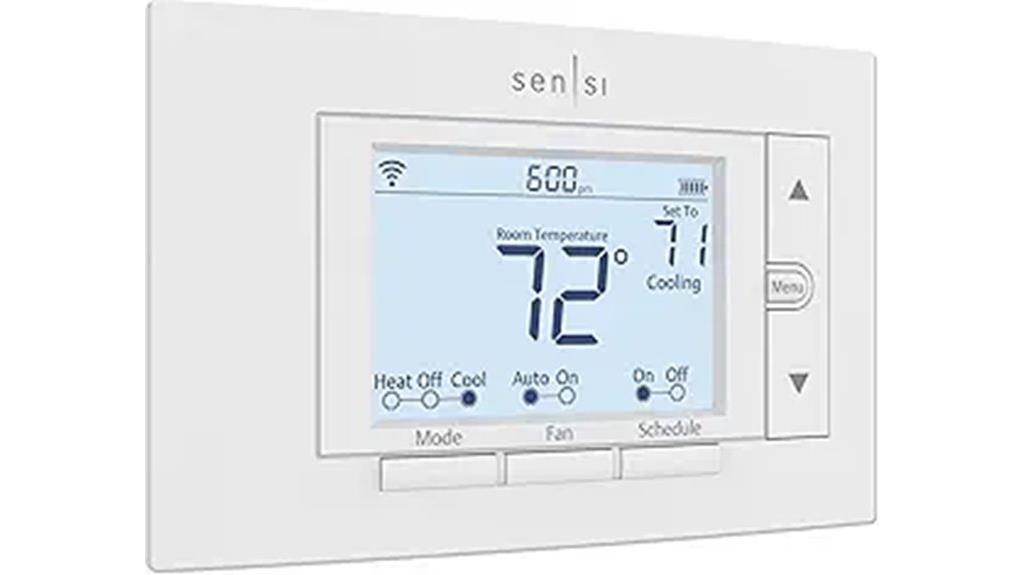
If you’re looking for a smart thermostat that combines easy DIY installation with reliable performance, the Sensi Smart Thermostat stands out as a top choice. Its Wi-Fi connectivity and programmable controls make managing your home’s climate simple, often without needing a c-wire. With a traditional look, a 5-inch LED display, and voice control via Alexa, Google Assistant, and others, it fits seamlessly into your home. Energy Star certified, it can save about 23% on HVAC energy through scheduling, remote access, and usage reports. Easy to install, it includes everything you need and offers a 3-year warranty, earning high user ratings for reliability and privacy.
Best For: homeowners seeking an easy-to-install, energy-efficient smart thermostat with reliable performance and privacy protection.
Pros:
- Simple DIY installation with included hardware and step-by-step app guidance
- Energy Star certified, capable of saving approximately 23% on HVAC energy
- Compatible with multiple voice assistants like Alexa and Google Assistant for hands-free control
Cons:
- May not be compatible with all complex or proprietary HVAC systems
- Lacks advanced features found in some high-end smart thermostats (e.g., advanced zoning)
- Requires a Wi-Fi connection for remote features, which may be a concern in low-connectivity areas
ecobee Smart Thermostat Enhanced, Wi-Fi Programmable Thermostat

The ecobee Smart Thermostat Enhanced is an excellent choice for homeowners who want to maximize energy savings without sacrificing comfort. It can save up to 26% annually on heating and cooling costs by automatically adjusting your home’s temperature when you’re away, avoiding unnecessary heating or cooling. It preheats or precools your house before you arrive, ensuring comfort from the moment you walk in. With smart sensors, it measures temperature in key rooms and adjusts for humidity, maintaining a consistent environment. Plus, it’s compatible with major smart home platforms and can be controlled remotely, making it both efficient and convenient.
Best For: homeowners seeking to maximize energy savings and comfort through smart, remote-controlled temperature management compatible with various HVAC systems.
Pros:
- Saves up to 26% annually on heating and cooling costs.
- Compatible with major smart home platforms (Siri, Alexa, Google Assistant) for easy voice and remote control.
- Incorporates SmartSensor and humidity adjustment for consistent comfort in key rooms.
Cons:
- Requires installation of Power Extender Kit in homes without C-Wire, which may be challenging for some users.
- Designed primarily for wired HVAC systems, limiting use with purely wireless setups.
- Advanced features and sensors may come at a higher initial cost compared to basic thermostats.
ecobee Smart Thermostat Premium with Sensors

For homeowners seeking precise temperature control and energy savings, the ecobee Smart Thermostat Premium with Sensors stands out as an excellent choice. It can save up to 26% annually on heating and cooling and is ENERGY STAR certified. The included SmartSensor helps eliminate hot or cold spots by adjusting room temperatures, while the built-in air quality monitor alerts me to poor air quality and suggests improvements. With a sleek, cinematic display and occupancy sensing, it offers a premium design and smart features like geofencing, open window alerts, and voice control compatibility with Siri, Alexa, and Google Assistant. Installation is straightforward, thanks to the Power Extender Kit, making it a versatile and smart upgrade.
Best For: homeowners seeking precise, energy-efficient temperature control with smart home integration and air quality monitoring.
Pros:
- Energy savings of up to 26% annually on heating and cooling.
- Includes SmartSensor to eliminate hot/cold spots and improve comfort.
- Compatible with multiple smart home platforms like Siri, Alexa, and Google Assistant.
Cons:
- Requires a subscription for advanced security features through ecobee Smart Security.
- Installation may be complex for those unfamiliar with HVAC wiring, despite included components.
- Price point may be higher compared to basic thermostats without advanced features.
Factors to Consider When Choosing Smart Thermostats With Learning Features

When selecting a smart thermostat with learning features, I focus on how well it works with my HVAC system and how easy it is to install. I also consider how effective its learning algorithm is, along with app and voice control options, to guarantee convenience. Finally, I look at its potential to save energy and cut costs over time.
Compatibility With HVAC Systems
Choosing a smart thermostat with learning features requires ensuring it’s compatible with your HVAC system’s specifics. First, check if it matches your system’s voltage, type, and configuration—whether gas, electric, oil, or a heat pump. Many thermostats need a common C-wire for constant power, though some can work without it using power extender kits. It’s also important to confirm if the thermostat supports multiple stages of heating and cooling, especially for complex or zoned systems. Compatibility with your HVAC brand and model matters too, as some thermostats work seamlessly with certain systems and may need adapters. To avoid surprises, use manufacturer compatibility checkers or online tools before purchasing, ensuring smooth integration with your existing setup.
Ease of Installation
Installing a smart thermostat with learning features can be straightforward, especially since many models are designed for DIY setup and can be completed in under 30 minutes. Most come with step-by-step guides and app instructions that make wiring and configuration simple. Compatibility with your existing HVAC system, particularly having a C-wire, can affect installation ease, but some models include self-setup features and automatic wiring detection to minimize complications. If your home lacks a C-wire, accessories like power extender kits can help, making installation smoother. These features are designed to reduce the need for professional help, saving you time and money. Overall, choosing a model with clear instructions and adaptive setup options can *considerably* simplify the installation process.
Learning Algorithm Effectiveness
A smart thermostat’s learning algorithm plays a crucial role in its ability to optimize comfort and energy efficiency, making it essential to take into account how well it predicts and adapts to your habits. A strong algorithm accurately forecasts your preferences and automatically refines its schedule over time, reducing the need for manual adjustments. The speed at which it learns impacts both your satisfaction and savings, so faster adaptation is preferable. Incorporating external factors like weather, sunlight, and occupancy patterns often boosts predictive accuracy, leading to better performance. Additionally, a robust algorithm maintains effectiveness despite changes in routines or unexpected system behaviors. When choosing a smart thermostat, consider how well its learning algorithm can adapt dynamically and reliably to ensure continuous comfort and energy efficiency.
App and Voice Control
When selecting a smart thermostat with learning features, considering its app and voice control capabilities is essential for seamless operation and convenience. A good app lets me monitor and adjust temperature settings, schedules, and energy data remotely, giving me control from anywhere. Many thermostats support voice commands via platforms like Alexa, Google Assistant, or Siri, allowing hands-free adjustments that are quick and effortless. These features often work best with a stable internet connection and compatible smart home systems, ensuring smooth communication. Some models even adapt their behavior based on my voice commands and usage patterns, boosting comfort and efficiency without extra effort. Overall, robust app and voice control features enhance the usability of smart thermostats, making managing home climate more intuitive and flexible.
Energy Saving Potential
Energy savings are a key reason many people choose smart thermostats with learning features. These devices can cut heating and cooling costs by an average of 10-15% annually, thanks to their ability to analyze routines and automatically adjust temperatures. When they accurately reflect your schedule, they prevent wasted energy, which can lead to savings of up to 26%. Many models provide energy reports and insights, helping you identify opportunities to optimize your usage further. Compatibility with utility programs and rebates can boost savings even more, making these thermostats a smart investment. Keep in mind, actual savings depend on your climate, household habits, and system compatibility. Overall, a learning thermostat is a powerful tool for reducing energy costs while maintaining comfort.
Sensor Integration Options
Choosing a smart thermostat with learning features means considering how well it integrates additional sensors to manage different rooms effectively. Many models support extra sensors, like temperature or combined temperature and occupancy units, which help optimize comfort and save energy. The placement and number of these sensors are vital—they influence how accurately the thermostat gauges room conditions and adjusts heating or cooling. Some thermostats automatically gather data from connected sensors, refining their scheduling algorithms over time for better comfort. Wireless, battery-powered sensors are common, making installation straightforward and flexible—they can be moved around easily to target hot or cold spots. By selecting a thermostat with versatile sensor integration options, you guarantee more precise climate control tailored to your home’s unique layout.
Compatibility With Smart Ecosystems
Ever since smart home technology has become mainstream, ensuring your thermostat works seamlessly within your existing ecosystem is vital. Compatibility with voice assistants like Google Assistant, Amazon Alexa, or Apple Siri allows effortless control. It’s also essential to check if the thermostat supports standards like Matter, which promotes interoperability across various devices. Verify whether it integrates smoothly with your preferred platform, such as Google Home, Apple HomeKit, or Samsung SmartThings. Additionally, confirm that it’s compatible with your HVAC system type, including heat pumps or zone control setups, especially if you lack a C-wire. Finally, look for compatibility with energy management services like Nest Renew or ecobee SmartEnergy, which help optimize energy use within your ecosystem. These considerations ensure a hassle-free, integrated smart home experience.
Design and Display Features
When selecting a smart thermostat with learning features, the design and display play a significant role in daily usability and aesthetic integration. I look for a larger, high-resolution screen because it makes reading temperature settings and energy data much easier. Features like Dynamic Farsight let me see important info from across the room without touching the thermostat, which is really convenient. Customizable displays, such as clock or weather modes, help match the device to my home’s decor and personal preferences. I also appreciate automatic brightness adjustment or manual controls to ensure good visibility in different lighting conditions. A sleek, modern design with polished finishes not only looks stylish but also blends seamlessly with various interior styles, elevating my home’s overall aesthetic.
Frequently Asked Questions
How Do Smart Thermostats With Learning Features Save Energy Effectively?
Smart thermostats with learning features save energy effectively by adapting to my routines and preferences. They analyze my daily habits, adjusting the temperature automatically to optimize comfort while minimizing waste. When I’m away or asleep, they reduce heating or cooling to save energy without sacrificing comfort. This intelligent adjustment guarantees I use less energy overall, lowering my utility bills and reducing my carbon footprint effortlessly.
Can These Thermostats Be Integrated With Smart Home Ecosystems?
Integrating smart thermostats with home ecosystems is like fitting pieces of a puzzle together seamlessly. I’ve found that most learning thermostats are compatible with popular systems like Alexa, Google Assistant, and Apple HomeKit. They connect effortlessly through apps, allowing me to control my climate from anywhere. This integration makes managing my home’s temperature intuitive and effortless, ensuring comfort and energy savings without any hassle.
Are There Any Privacy Concerns With Learning Thermostats Collecting Data?
Yes, there are privacy concerns with learning thermostats collecting data. I stay cautious by reviewing their privacy policies and understanding what data they gather. I also make sure that my device has strong security features, like encryption, to protect my information. While these thermostats offer convenience, I believe it’s important to be aware of how my data is used and to take steps to safeguard my privacy.
How Do Learning Thermostats Adapt to Changing Seasonal Temperature Patterns?
Imagine your thermostat’s like a weather wizard, constantly observing seasonal shifts and adjusting itself without you lifting a finger. It learns your patterns over time—whether you like cozy winters or cool summers—and fine-tunes the temperature accordingly. As the seasons change, it adapts seamlessly, ensuring your home’s climate stays just right, all while you go about your day, blissfully unaware of the calculations happening behind the scenes.
What Is the Typical Setup Process for a Smart Thermostat With Learning Capabilities?
Setting up a smart thermostat with learning features is pretty straightforward. First, I turn off my old thermostat and remove it. Then, I connect the new device to my Wi-Fi and follow the on-screen instructions or app prompts. I usually enter my home’s details and set preferences. Finally, I let it run for a few days so it can learn my schedule and adjust automatically, making home comfort effortless.
Conclusion
Choosing the right smart thermostat with learning features can truly transform your home’s comfort and efficiency. Did you know that smart thermostats can save you up to 12% on heating and cooling bills? With options like the Nest Learning Thermostat and ecobee models, you’ll find a device that fits your needs perfectly. Investing in one of these smart systems means you’ll enjoy a more comfortable home while reducing energy costs—it’s a smart move for any homeowner.
